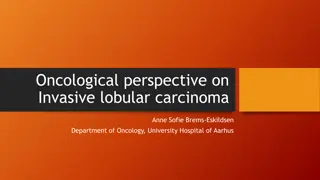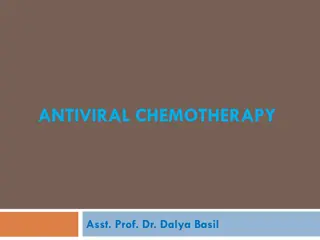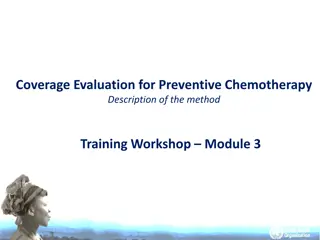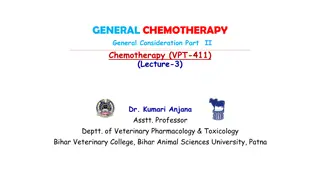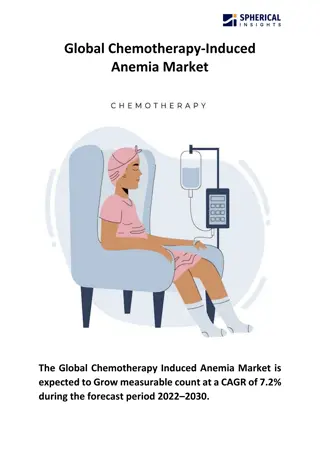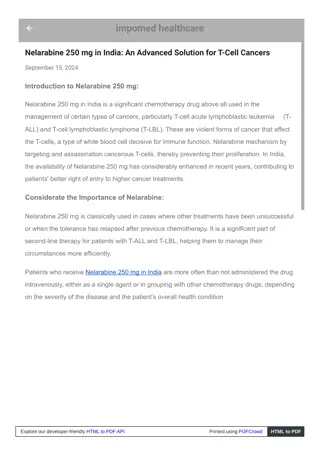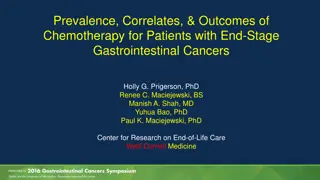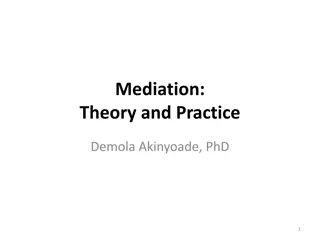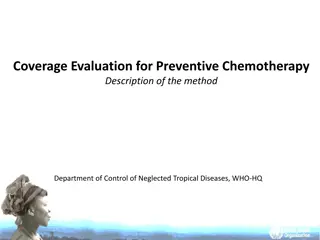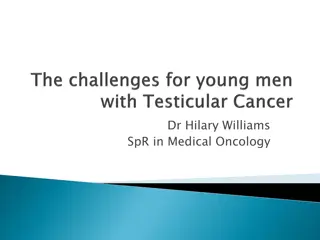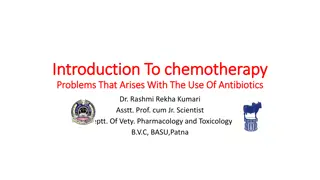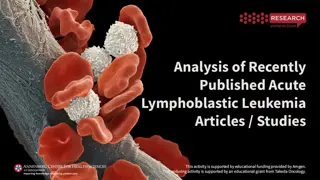
Adverse Effects of Chemotherapy: A Comprehensive Overview
Explore the diverse adverse effects of chemotherapy discussed by Dr. Saba Ghaffary, Assistant Professor of Clinical Pharmacy at Tabriz University of Medical Sciences. Learn about common and acute toxicities, specific organ toxicities, and how factors influence the degree of cytopenia in patients undergoing chemotherapy.
Download Presentation

Please find below an Image/Link to download the presentation.
The content on the website is provided AS IS for your information and personal use only. It may not be sold, licensed, or shared on other websites without obtaining consent from the author. If you encounter any issues during the download, it is possible that the publisher has removed the file from their server.
You are allowed to download the files provided on this website for personal or commercial use, subject to the condition that they are used lawfully. All files are the property of their respective owners.
The content on the website is provided AS IS for your information and personal use only. It may not be sold, licensed, or shared on other websites without obtaining consent from the author.
E N D
Presentation Transcript
Adverse Effects of Chemotherapy Dr. Saba Ghaffary Assistant Professor of Clinical Pharmacy Tabriz University of Medical Sciences
Classification Common and acute toxicities Specific organ toxicities Long-term complications
Common and acute toxicities Hematologic Toxicities Gastrointestinal Tract Toxicities Dermatologic Toxicities
Hematologic Toxicities This process is regulated by several cytokines
Myelosuppression Decreased RBCs can cause anemia (120 days) Fatigue and decreased exercise tolerance. Having low neutrophil counts ( 8 hours) Increases a patient's risk for bacterial infections Reduced platelets & thrombocytopenia (10 days) Bleeding from the GI and genitourinary tracts.
Both patient-related and agent-related factors can influence the degree of cytopenia Agent-related factors a) Specific agent b) dose intensity c) dose density Host factors a) Patient age b) Bone marrow reserve c) The degree of myelosuppression from previous cytotoxic chemotherapy, radiation therapy, or both d) The ability of the liver or kidney to metabolize and excrete the compounds administered.
With most myelosuppressive agents, the patient's WBC and platelet counts begin to fall within 5 to 7 days of cytotoxic therapy administration, reach a nadir within 7 to 10 days, and recover within 14 to 26 days. a) Dose reduction b) CSFs Filgrastim Pegfilgrastim
Dosing of CSFs Filgrastim 5 mcg/ kg/ day as a single daily SC injection Pegfilgrastim Once per cycle as 6 mg SC in adult patients regardless of patient weight Discontinue the CSF when the neutrophil count reaches 2,000 to 4,000 cell/ L Bone pain (in sternum and pelvic region) is most commonly experienced when patients begin to recover peripheral blood cells after their nadir (Usually is relieved with analgesic agents)
Thrombocytopenia Oprelvekin 50 mcg/kg/day SC until the postnadir platelet count is greater than 50,000 cells/ L or up to 21 days after chemotherapy. peripheral edema, dyspnea, and pleural effusions only about 20% of patients respond to oprelvekin
Anemia and erythropoietin Anemia usually is not a dose-limiting toxicity commonly associated with cytotoxic chemotherapy, because RBCs survive approximately 120 days. Chemotherapy predominantly affects RBCs by causing anisocytosis and macrocytosis Folic acid analogs, hydroxyurea, purine antagonists, and pyrimidine antagonists Anemia commonly occurs in cancer patients secondary to the primary disease and chemotherapy
Recombinant human erythropoietin 150 units/ kg three times per week rounded to a standard dose of 10,000 units Or 40,000 units once weekly For 4 weeks If the Hgb increases less than 1 g/dL, then the dose should be increased to 300 units/kg three times weekly or 60,000 units once weekly. patients who do not respond positively within 6 to 8 weeks should discontinue therapy. Increased risk for thromboembolic events. Hgb concentration less than 10 g/dL. Increased mortality in Hgb levels greater than 12 g/dL
THROMBOTIC EVENTS Up to one-third of apparently healthy adults who exhibit otherwise unexplained deep vein thrombosis eventually are proved to have a malignancy. risk factors: type of cancer, stage of cancer, comorbidities, mobility, and type of systemic anticancer therapy Pancreatic, stomach, kidney, lung, brain, and uterine, APL thalidomide, lenalidomide, and bevacizumab
GASTROINTESTINAL TRACT TOXICITIES The GI tract may be second only to bone marrow in its susceptibility to toxic effects produced by cytotoxic chemotherapy Nausea and vomiting Oral complications Esophagitis Lower bowel disturbances
Nausea and vomiting Anticancer agents or their metabolites may stimulate dopamine or serotonin receptors in the GI tract, the chemoreceptor trigger zone, or the central nervous system (CNS), which ultimately act on the vomiting center. Acute: chemotherapy and can last for the first 24 hours. few hours after the administration of the Delayed: Peak in about 2 to 3 days and can last 6 to 7 days
RISK FACTORS Age younger than 50 years Female sex Poor control of symptoms in prior cycles History of motion sickness or nausea with pregnancy, anxiety, or depression Shorter infusion time Higher dose More chemotherapy cycles
EMETOGENICITY OF AGENTS High risk agents >90% of patients with symptoms Moderate-risk agents 30% to 90% of patients with symptoms Low emetogenicity agents Cause symptoms in 10% to 30% of patients
TREATMENT Combinations of antiemetics from different therapeutic classes will be more effective in most situations than a single agent. 5-HT3 antagonists NK1 antagonist Corticosteroids
COMPLICATIONS OF THE ORAL CAVITY Mucositis Xerostomia Infection Bleeding These toxicities occur because of the nonspecific effects of chemotherapy on cells undergoing rapid division, including the cells of the mouth that undergo rapid renewal with a turnover time equal to 7 to 14 days. Reduces the renewal rate of the basal epithelium and can cause mucosal atrophy, as well as glandular and collagen degeneration.
Radiation therapy to the head and neck also causes mucosal atrophy by decreasing cell renewal. Radiation can also cause fibrosis of the salivary glands, muscles, ligaments, and blood vessels, and damage to the taste buds. The combined effects of chemotherapy and radiation therapy on the oral mucosa can also cause infection and bleeding in the oral cavity. Because the oral mucosa is highly vascular and frequently traumatized, bleeding occurs commonly with thrombocytopenia. cytotoxic chemotherapy and neutropenia can alter the extensive microbial flora harbored in the oral cavity, thus leading to oral infections.
MUCOSITIS Signs and symptoms generally occur about 5 to 7 days after chemotherapy or at almost any point during radiation therapy. Lesions approximately 1 to 3 weeks, depending on their severity generally regress and resolve completely in methotrexate fluorouracil cytarabine doxorubicin etoposide melphalan bleomycin 1) 2) 3) 4) 5) 6) 7)
TREATMENT Topical anesthetics Equal portions of lidocaine, diphenhydramine, and magnesium-containing or aluminum-containing antacids Sucralfate Gelclair A bio-adherent oral gel containing polyvinylpyrrolidone, hyaluronic acid, and glycyrrhetinic acid
PREVENTION Ice chips Chlorhexidine gluconate 0.12% Palifermin (a keratinocyte growth factor)
XEROSTOMIA (DRY MOUTH) One of the most frequent side effects of radiation therapy to the head and neck Loss of salivary buffering capacity Lower salivary pH Decreased salivary immunoglobulin A Reduction of saliva production Alter the sense of taste Causes dental caries
MANAGEMENT Pilocarpine Saliva substitutes Sugar free gum or hard candy Ice chip Amifostine An organic thiophosphate chemoprotectant agent,
LOWER GASTROINTESTINAL TRACT COMPLICATIONS Malabsorption Villus atrophy and cessation of mitosis within GI crypts Swelling and dilation of mitochondria and endoplasmic reticulum and shortening of the microvilli. Diarrhea Irinotecan, high-dose cytarabine, or fluorouracil. Constipation Vinca alkaloids, thalidomide.
DIARRHEA Irinotecan Early-onset and late-onset diarrhea Atropine IV or SC 0.25 to 1 mg for early onset Loperamide 4 mg with the first episode of diarrhea and repeat doses of 2 mg every 2 hours until 12 hours have passed without a bowel movement
Dermatologic toxicities Alopecia Hyperpigmentation Radiation recall Photosensitivity Nail changes Hand-foot syndrome Acneiform rashes Hypersensitivity reactions Extravasations
Alopecia Because hair bulb cells replicate every 12 to 24 hours, the cells are susceptible to cytotoxic agents Thinned or weakened hair shaft or failure to form hair Begins 7 to 10 days after one treatment, with prominent hair loss noted within 1 or 2 months. Regeneration 1 to 2 months after therapy completion The color and texture of hair may be altered; the new hair may be lighter, darker, or curlier as it regrows. Cyclophosphamaide, antracyclines, melphalan, etoposide
NAIL CHANGES The growth of fingernails and toenails is arrested in a manner similar to hair growth. Within weeks, these pale horizontal lines ( Beau s lines ) begin to appear in the nail beds (in patients receiving chemotherapy for more than 6 months). normally disappear from the fingernails in approximately 6 months. 40% with paclitaxel and docetaxel cyclophosphamide, fluorouracil, daunorubicin, doxorubicin, bleomycin are less well understood.
DERMATOLOGIC PIGMENT CHANGES hyperpigmentation> hypopigmentation widespread cutaneous hyperpigmentation: Busulfan, cyclophosphamide, fluorouracil, dactinomycin, and hydroxyurea Methotrexate can cause hyperpigmented banding of light- colored hair, flag sign of chemotherapy. peculiar serpiginous hyperpigmentation (5fu and bleomycin)
Hand-foot syndrome acral erythema or the palmar-plantar erythrodysesthesia Tender, erythematous skin on the palms of hands and sometimes on the soles of feet, Tingling, burning, or shooting sensations in their hands or feet Cytarabine, fluorouracil, doxorubicin, liposomal doxorubicin, methotrexate, capecitabine, and hydroxyurea, sunitinib and sorafenib Discontinuation of the medication will help to resolve the reaction
Irritant and vesicant reactions Transient local irritation Irritation of the vein Extravasation Agents known to bind to DNA (i.e., the anthracyclines) have the propensity to produce the most severe damage
Management Stopping the injection Cold compresses to the extravasation site and elevation of the extremity Warm compresses Vinca alkaloids, Epipodophyllotoxins Specific antidotes Dexrazoxane Hyaluronidase
Neurotoxicity Methotrexate High-dose IV methotrexate causes acute encephalopathy Is usually transient and reversible menangitis High doses of cytarabine Encephalopathy Cerebellar dysfunction menangitis Leukoencephalopathy Asparaginase and PEG-aspargase Encephalopathy Stupor, coma, excessive somnolence, disorientation, hallucination, or severe depression
Peripheral neuropathy Vincristine, Vinblastine & Vinorelbine cisplatin & Oxaliplatin Etoposide Paclitaxel & Docetaxel Bortezomib Thalidomide & Lenalidomide Unlike the vinca alkaloids, most of these agents cause numbness only and not a loss of reflexes, or weakness. Patients may report sensory loss and pain, incidence may be related to cumulative doses as well as individual risk factors such as history of diabetic neuropathy.
Peripheral neuropathy Vincristine and vinblastine Paresthesia (numbness and tingling) involving the feet and hands (within the first days to weeks of therapy.) peripheral nerve toxicity commonly is bilateral and symmetric and is often referred to as a stocking-glove neuropathy. Pain and temperature sensory loss Depression of deep tendon reflexes Motor weakness with a foot drop or muscle atrophy These complications are either partially or completely reversible, but recovery often takes several months.
Oxaliplatin Oxaliplatin-induced neurotoxicity manifests as an acute neurosensory complex as well as a cumulative sensory neuropathy. Hyper excitability of peripheral nerves causes an 85% to 95% incidence of paresthesia and dysesthesias of the hands, feet, and the perioral region. These effects are precipitated by exposure to cold. Calcium and magnesium infusions
Cranial nerve toxicity Vinca alkaloids Ptosis or ophthalmoplegia Trigeminal neuralgia, facial palsy, and vocal cord paralysis Jaw pain Cisplatin Ototoxicity direct toxic effect on the cochlea
Autonomic neuropathy Vincristine & vinblastine Colicky abdominal pain with or without constipation Prophylactic laxatives Senna derivatives or bisacodyl and stool softeners also may be used concurrently Bladder atony with urinary retention Impotence Orthostatic hypotension
Cardiotoxicity Cardiomyopathy: Anthracycline Formation of reactive oxygen species Risk factors: Total cumulative dose Mediastinal radiation therapy Pre-existing cardiac disease Hypertension Concurrent chemotherapy agents Prevention: Low doses administered weekly or prolonged continuous IV infusions Dexrazoxane is a chemoprotectant that reduces the incidence and severity of cardiomyopathy
Trastuzumab Dyspnea, increased cough, peripheral edema, and reduced ejection fraction direct and not dependent on cumulative dose or treatment duration Arrhythmias Doxorubicin Paclitaxel Dasatinib, nilotinib, lapatinib, pazopanib, and sunitinib Hypertension Bevacizumab,sunitinib, sorafenib, and pazopanib
Nephrotoxicity Cisplatin, a platinum heavy-metal complex Dose limiting toxicity Acute renal failure Tubular dysfunction and decreased GFR Proximal tubular dysfunction causes urinary excretion of protein and magnesium as well as decreased reabsorption of salt and water Hypomagnesemia, hypocalcemia, hyponatremia, and hypokalemia Chronic renal failure
Prevention Hydration with saline 2 to 3 L of normal saline during 8 to 12 hours to maintain a urine output of 100 to 200 mL/hr for at least 6 hours after treatment Prophylactic magnesium 16 mEq IV daily during a 5-day course of cisplatin followed by 60 mEq orally (20 mEq three times daily) between courses Amifostine scavenges the free radicals 910 mg/m2, once daily as a 15-minute IV infusion, 30 minutes before chemotherapy Can cause significant hypotension Dose reduction in decreased GFR
Proteinuria Bevacizumab, an anti-VEGP monoclonal antibody Inhibition of nitric oxide synthesis Lead to an increase in peripheral resistance and endothelial dysfunction Glomerular injury lead to glomerulonephritis
Acute Tubular Obstruction Methotrexate Tubular precipitation (poorly soluble at a pH less than 7) Hydration and brisk diuresis to produce urine output of 100 to 200 mL/hour for at least 24 hours after administration. A urine pH greater than 7.0 by administration of 25 to 50 mEq/L sodium bicarbonate within the hydration fluid.
Hemorrhagic Cystitis Ifosfamide Acrolein is responsible for urotoxicity causing a direct irritation of the bladder mucosa Painful urination, frequency, and hematuria. Mesna for prevention 20% of the ifosfamide dose given at zero, 4, and 8 hours after ifosfamide (for a total mesna dose of 60% of the ifosfamide dose). Repeated administration is required because mesna has a much shorter elimination halflife (<1 hour) than ifosfamide.
Pulmonary Toxicities Bleomycin The highest incidence of pulmonary toxicity Interstitial pneumonitis followed by pulmonary fibrosis nonproductive cough and dyspnea The most significant factor is the cumulative dose Mortality is about 50% Chlorambucil and cyclophosphamide


